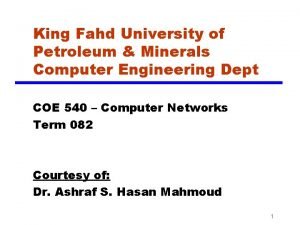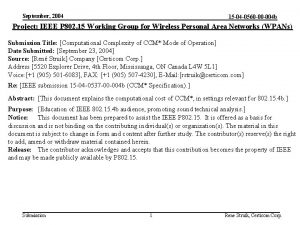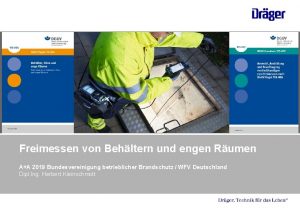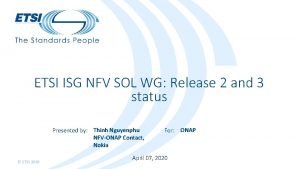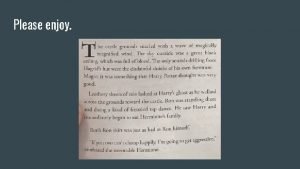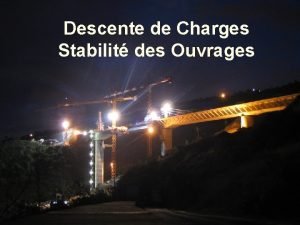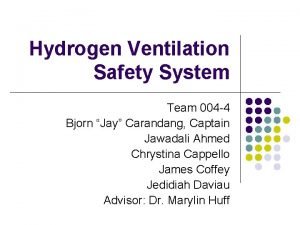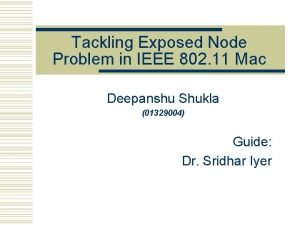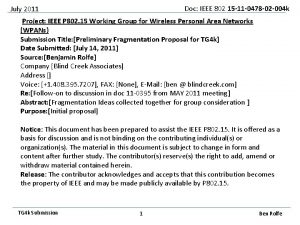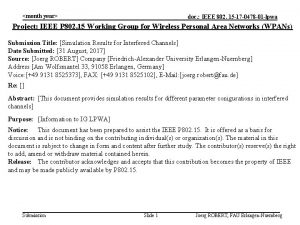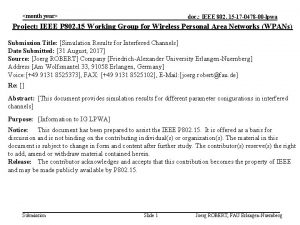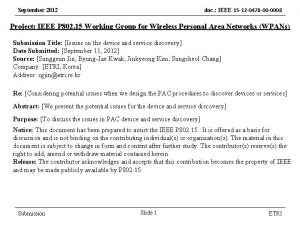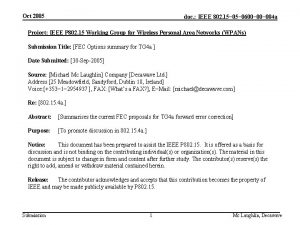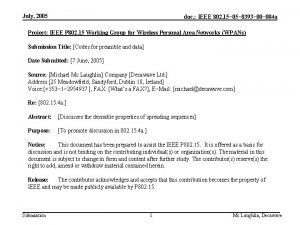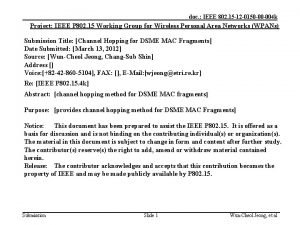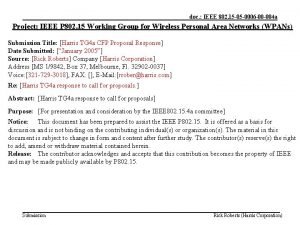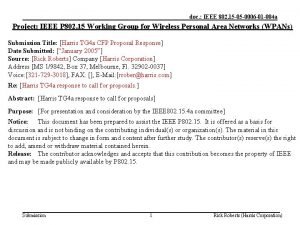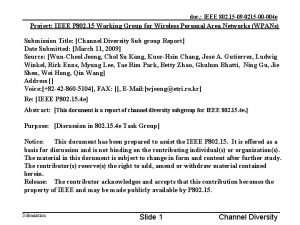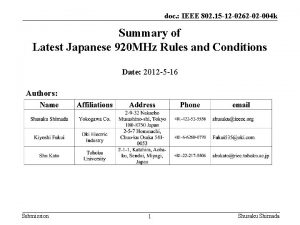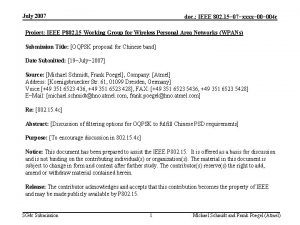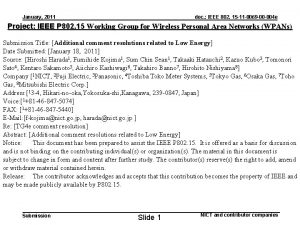Doc IEEE 802 15 11 0478 01 004



















- Slides: 19

Doc: IEEE 802 15 -11 -0478 -01 -004 k July 2011 Project: IEEE P 802. 15 Working Group for Wireless Personal Area Networks (WPANs) Submission Title: [Preliminary Fragmentation Proposal for TG 4 k] Date Submitted: [July 14, 2011] Source: [Benjamin Rolfe] Company [Blind Creek Associates] Address [] Voice: [+1. 408. 395. 7207], FAX: [None], E-Mail: [ben @ blindcreek. com] Re: [Follow-on to discussion in doc 11 -0395 from MAY 2011 meeting] Abstract: [Fragmentation Ideas collected together for group consideration ] Purpose: [Initial proposal] Notice: This document has been prepared to assist the IEEE P 802. 15. It is offered as a basis for discussion and is not binding on the contributing individual(s) or organization(s). The material in this document is subject to change in form and content after further study. The contributor(s) reserve(s) the right to add, amend or withdraw material contained herein. Release: The contributor acknowledges and accepts that this contribution becomes the property of IEEE and may be made publicly available by P 802. 15. TG 4 k Submission 1 Ben Rolfe

Doc: IEEE 802 15 -11 -0478 -01 -004 k July 2011 Introduction • Combination of inputs – Ideas shared in May 2011 meeting – Teleconference call discussions – Email received via reflector and directly • Reference documents: – P 802. 15 -11 -0395 -00 – P 802. 15 -11 -0348 -00 TG 4 k Submission Slide 2 Ben Rolfe

Doc: IEEE 802 15 -11 -0478 -01 -004 k July 2011 Goals for Fragmentation • Adapt LECIM PHYs to operate with existing MAC transparently • Improve apparent reliability of the medium • Fit expected channel conditions, data rates and other PHY characteristics for LECIM • Reduce on the air overhead • Coexistence: reduce interference footprint and improve interference tolerance • Consider generalizations to make useful beyond LECIM PHYs and applications TG 4 k Submission Slide 3 Ben Rolfe

Doc: IEEE 802 15 -11 -0478 -01 -004 k July 2011 PHY proposals drive specifics • General concepts for fragmentation derived from requirements, channel model, and discussions of PHY characteristics discussed so far needed to meet those requirements • Will Refine and adjust as PHY proposals presented, considered and converged – May be more essential for some proposals for others (ex: shared spectrum vs licensed bands) TG 4 k Submission Slide 4 Ben Rolfe

Doc: IEEE 802 15 -11 -0478 -01 -004 k July 2011 What we know • Application requirements => very low bit rates (< 40 kbps) => Expected PHY rates of 1 to 40 kbps • Provisioned, asymmetrical end-points => Star topology likely • Channel characteristics: – Use of shared spectrum likely => interference mitigation and coexistence important – Short term channel conditions change over the duration of 15. 4 MAC frame at LECIM data rates (channel coherence time) • Must be compatible with existing MAC – Compatible with higher layer protocols typically used with 15. 4 is a good thing too! – May have fragmentation/compression being used above the MAC (i. e. 6 lo. WPAN like protocols) TG 4 k Submission Slide 5 Ben Rolfe

Doc: IEEE 802 15 -11 -0478 -01 -004 k July 2011 Packet Duration Examples Example Maximum packet Duration (ms) Reference packet * duration (ms) 802. 15. 4 DSSS @ 250 kbps 4. 25 ms 4. 12 ms 802. 15. 4 FSK @ 100 kbps 10. 64 ms 10. 32 ms Ethernet @ 10 Mbps 1. 22 ms 0. 012 ms 802. 11 @ 54 Mbps 0. 6 ms 0. 04 ms 802. 11 @ 2 Mbps 16. 4 ms 1. 02 ms 802. 16 @ Fixed DL duration 0. 2 to 2 ms *Reference packet = 100 octets payload + average overhead bits (PHY and MAC) TG 4 k Submission Slide 6 Ben Rolfe

Doc: IEEE 802 15 -11 -0478 -01 -004 k July 2011 PHY packet size for LECIM? • Typical packet duration “real world” ranges from < 1 ms to ~16 ms • LECIM data rates < 40 kbps (may be much lower) • 20 octet packet => – 4 ms @ 40 kbps – 8 ms @ 20 kbps – 16 ms @ 10 kbps • Packet size <= 20 octets seems likely – Aligns well with channel model (coherence time) – Might need to be << 20 in some situations TG 4 k Submission Slide 7 Ben Rolfe

Doc: IEEE 802 15 -11 -0478 -01 -004 k July 2011 MSDU -> multiple MPDUs MAC Frame Overhead • 802. 15. 4 MAC frame example – 802. 15. 4 2006 frame: 23 octets + payload 2 1 8 8 FCF DSN SRC Addr Dest Addr 2 Variable 2 PANID MSDU FCS • 802. 15. 4 e frame: 20 octets + payload 2 8 8 FCF SRC Addr Dest Addr Variable 2 MSDU FCS • Fragmenting MPDU makes sense TG 4 k Submission Slide 8 Ben Rolfe

Doc: IEEE 802 15 -11 -0478 -01 -004 k July 2011 Overview of Fragmentation • MPDU constructed in the normal 15. 4 process • Fragment 15. 4 MPDU into multiple PHY packets (Compress/suppress repetition MHR fields) • Fragment carries minimal overhead • Each fragment validated, acknowledged • Retransmission of failed fragments only • Example: fixed PPDU size =20 octets TG 4 k Submission Slide 9 Ben Rolfe

Doc: IEEE 802 15 -11 -0478 -01 -004 k July 2011 TG 4 k Submission Slide 10 Ben Rolfe

Doc: IEEE 802 15 -11 -0478 -01 -004 k July 2011 State information associated with MSDU • Destination address • MSDU ID • Transfer type: – Acknowledged or not acknowledged • PHY specific transmit parameters – TX power/SF/bits per symbol/, FEC, etc depending on PHY TG 4 k Submission Slide 11 Ben Rolfe

Doc: IEEE 802 15 -11 -0478 -01 -004 k July 2011 MPDU Construction and Fragmentation • MPDU constructed by existing 802. 15. 4 MAC process • Fragmented into a sequence of fragmentation cells [FP 1, …FPn] that each fit into a PPDU • MAC overhead (MHR, Security header, MPDU FCS) sent only once TG 4 k Submission Slide 12 Ben Rolfe

Doc: IEEE 802 15 -11 -0478 -01 -004 k July 2011 Fragmentation Cell Construction Fragment Sequence ID Fragment Number AR More /end PHY info MPDU Data Fragment • Fragment Sequence ID identifies this collection of fragments – Determined by MSDU ID, Destination address; MSDU ID associated with destination address once at start of sequence (Link context) • • Fragment number (which fragmentation cell is this in sequence) Per-fragment acknowledgment request More fragments/end of fragment sequence PHY info – Medium quality/status measurement (LQI) – Other PHY specific info appropriate? • Fragment Error Detection – Need to retransmit individual fragments – CRC, block code, FEC? ? TG 4 k Submission Slide 13 Ben Rolfe

Doc: IEEE 802 15 -11 -0478 -01 -004 k July 2011 Link Adaptation • Channel conditions change during MPDU duration == need to support PHY parameter adjustment between fragments • Provide medium quality indication in each fragment and response (‘the last time I heard you…’) • PHY defines what can be adjusted • Medium quality (LQI) method PHY specific TG 4 k Submission Slide 14 Ben Rolfe

Doc: IEEE 802 15 -11 -0478 -01 -004 k July 2011 MPDU Reassembly • Reassemble MPDU using fragment sequence ID and fragment number • Identify missing and/or invalid fragments • Request retransmission of missing fragments • Pass reassembled MPDU on for further MAC processing TG 4 k Submission Slide 15 Ben Rolfe

Doc: IEEE 802 15 -11 -0478 -01 -004 k July 2011 Fragment and MPDU Validation • levels of validation – Per fragment validation and retransmission – Validation of reassembled MPDU using MFR FCS – Message integrity/authentication? • Fragment Retransmission alternatives – Progressive acknowledgement and retransmission of individual Fragments – Aggregated acknowledgement followed by retransmission of missed fragments – Parameterized progressing (Hybrid) acknowledgment (incremental aggregation) • MPDU validation and retransmission – Using existing MAC validation and acknowledge procedures TG 4 k Submission Slide 16 Ben Rolfe

Doc: IEEE 802 15 -11 -0478 -01 -004 k July 2011 Conclusion – Leverages the existing 802. 15. 4 MAC frame structures – Fits MAC frame structures into smaller chunks appropriate to LECIM PHY characteristics to contain PPDU duration – Incremental effort improves MPDU delivery reliability, and reduces OTR overheads – Adaptable to a variety of PHYs and data rates – May be generalized for other PHYs TG 4 k Submission Slide 17 Ben Rolfe

Doc: IEEE 802 15 -11 -0478 -01 -004 k July 2011 Next Steps • Revise/Refine concept as LECIM PHY(s) develop • Areas (I know of) that need more analysis – Fragment context: need to know how many fragments to expect and when to give up on the sequence? – Parameterized hybrid ACK scheme to support upper layer adaptation – Need to validate each FP in such a way as to detect spoof'd fragments? TG 4 k Submission Slide 18 Ben Rolfe

Doc: IEEE 802 15 -11 -0478 -01 -004 k July 2011 Thanks for your Attention! TG 4 k Submission Slide 19 Ben Rolfe











